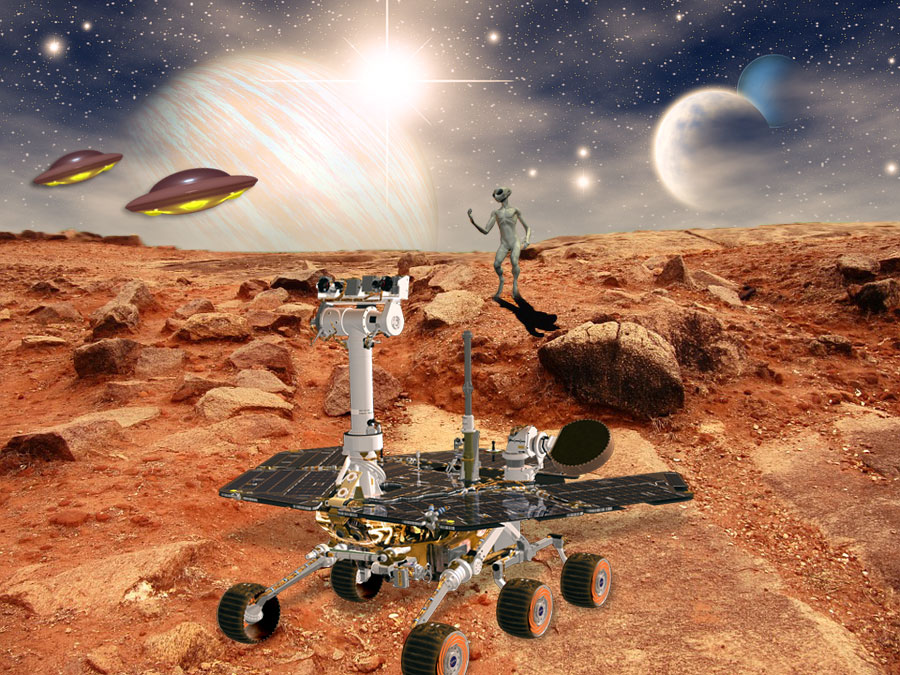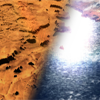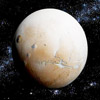Is NASA Any Closer To Admitting There Is Life On Mars?
 NASA’s Timeline Of Martian Discoveries – What’s Old Is New Again And Again
NASA’s Timeline Of Martian Discoveries – What’s Old Is New Again And Again
Earlier in Mar’s history, polar ice caps were discovered in the mid-17th century. In the latter part of the 18th century, William Herschel proved they grow and shrink alternately, in the summer and winter of each hemisphere.
NASA’s primary mission of the Viking probes of the mid-1970s was to carry out experiments designed to detect microorganisms in Martian soil because the favorable conditions for the evolution of multicellular organisms ceased some four billion years ago on Mars. The tests were formulated to look for microbial life similar to that found on Earth. Of the four experiments, only the Labeled Release (LR) experiment returned a positive result, showing increased CO2 production on first exposure of soil to water and nutrients.
In June 2000, possible evidence for current liquid water flowing at the surface of Mars was discovered in the form of flood-like gullies. Additional similar images were published in 2006, taken by the Mars Global Surveyor, that suggested that water occasionally flows on the surface of Mars.
The 2001 Mars Odyssey found much evidence for water on Mars in the form of images, and with its neutron spectrometer, it proved that much of the ground is loaded with water ice. Mars has enough ice just beneath the surface to fill Lake Michigan twice. In both hemispheres, from 55° latitude to the poles, Mars has a high density of ice just under the surface; one kilogram of soil contains about 500 grams (18 oz) of water ice. But close to the equator, there is only 2% to 10% of water in the soil. Scientists think that much of this water is also locked up in the chemical structure of minerals, such as clay and sulfates. Although the upper surface contains a few percent of chemically-bound water, ice lies just a few meters deeper, as it has been shown in Arabia Terra, Amazonis quadrangle, and Elysium quadrangle that contain large amounts of water ice. The orbiter also discovered vast deposits of bulk water ice near the surface of equatorial regions.[
Possible trace amounts of methane in the atmosphere of Mars were first discovered in 2003 with Earth-based telescopes and fully verified in 2004 by the ESA Mars Express spacecraft in orbit around Mars.
In February 2005, it was announced that the Planetary Fourier Spectrometer (PFS) on the European Space Agency’s Mars Express Orbiter had detected traces of formaldehyde in the atmosphere of Mars. Vittorio Formisano, the director of the PFS, has speculated that the formaldehyde could be the byproduct of the oxidation of methane and, according to him, would provide evidence that Mars is either extremely geologically active or harboring colonies of microbial life.
On July 28, 2005, the European Space Agency announced the existence of a crater partially filled with frozen water; some then interpreted the discovery as an “ice lake”. Images of the crater, taken by the High Resolution Stereo Camera on board the European Space Agency’s Mars Express orbiter, clearly show a broad sheet of ice in the bottom of an unnamed crater located on Vastitas Borealis, a broad plain that covers much of Mars’ far northern latitudes, at approximately 70.5° North and 103° East.
On June 19, 2008, NASA announced that dice-sized clumps of bright material in the “Dodo-Goldilocks” trench, dug by the robotic arm, had vaporized over the course of four days, strongly indicating that the bright clumps were composed of water ice that sublimes following exposure.
In 2008, research with the Shallow Radar on the Mars Reconnaissance Orbiter provided strong evidence that the lobate debris aprons (LDA) in Hellas Planitia and in mid northern latitudes are glaciers that are covered with a thin layer of rocks. Its radar also detected a strong reflection from the top and base of LDAs, meaning that pure water ice made up the bulk of the formation.
In July 2008, NASA announced that the Phoenix lander had confirmed the presence of water ice at its landing site near the northern polar ice cap (at 68.2° latitude). This was the first ever direct observation of ice from the surface. Two years later, the shallow radar on board the Mars Reconnaissance Orbiter took measurements of the north polar ice cap and determined that the total volume of water ice in the cap is 821,000 cubic kilometres (197,000 cu mi). That is equal to 30% of the Earth’s Greenland ice sheet, or enough to cover the surface of Mars to a depth of 5.6 metres (18 ft).
Research published in September 2009, demonstrated that some new craters on Mars show exposed, pure water ice. After a time, the ice disappears, evaporating into the atmosphere. The ice is only a few feet deep. The ice was confirmed with the Compact Imaging Spectrometer (CRISM) on board the Mars Reconnaissance Orbiter.
Relatively recent assessments published in December 2010 by Rafael Navarro–Gonzáles indicate that organic compounds “could have been present” in the soil analyzed by both Viking 1 and 2.
In August 2011, NASA announced the discovery by Nepalese American undergraduate student Lujendra Ojha of current seasonal changes on steep slopes below rocky outcrops near crater rims in the Southern hemisphere. These dark streaks, now called recurrent slope lineae, were seen to grow downslope during the warmest part of the Martian Summer, then to gradually fade through the rest of the year, recurring cyclically between years. The researchers suggested these marks were consistent with salty water (brines) flowing downslope and then evaporating, possibly leaving some sort of residue.
On 26 April 2012, scientists reported that an extremophile lichen survived and showed remarkable results on the adaptation capacity of photosynthetic activity within the simulation time of 34 days under Martian conditions in the Mars Simulation Laboratory (MSL) maintained by the German Aerospace Center (DLR).
In December 2012, NASA reported that Curiosity performed its first extensive soil analysis, revealing the presence of water molecules, sulfur and chlorine in the Martian soil.
In March 2013, NASA reported evidence of mineral hydration, likely hydrated calcium sulfate, in several rock samples including the broken fragments of “Tintina” rock and “Sutton Inlier” rock as well as in veins and nodules in other rocks like “Knorr” rock and “Wernicke” rock. Analysis using the rover’s DAN instrument provided evidence of subsurface water, amounting to as much as 4% water content, down to a depth of 60 cm (2.0 ft), in the rover’s traverse from the Bradbury Landing site to the Yellowknife Bay area in the Glenelg terrain.
On September 26, 2013, NASA scientists reported the Mars Curiosity rover detected abundant chemically-bound water (1.5 to 3 weight percent) in soil samples at the Rocknest region of Aeolis Palus in Gale Crater.
On 16 December 2014, NASA reported the Curiosity rover detected a “tenfold spike”, likely localized, in the amount of methane in the Martian atmosphere. Sample measurements taken “a dozen times over 20 months” showed increases in late 2013 and early 2014, averaging “7 parts of methane per billion in the atmosphere.” In addition, organic chemicals were detected in powder drilled from a rock by the Curiosity rover
On 24 March 2015, NASA reported that the SAM instrument on the Curiosity rover detected nitrates by heating surface sediments. The nitrogen in nitrate is in a “fixed” state, meaning that it is in an oxidized form that can be used by living organisms.
On April 13, 2015, Nature published an analysis of humidity and ground temperature data collected by Curiosity, showing evidence that films of liquid brine water form in the upper 5 cm of Mars’s subsurface at night.
On November 22, 2016, NASA reported finding a large amount of underground ice in the Utopia Planitia region of Mars. The volume of water detected has been estimated to be equivalent to the volume of water in Lake Superior
Using the HiRISE camera on board the Mars Reconnaissance Orbiter (MRO), researchers found in 2017 at least eight eroding slopes showing exposed water ice sheets as thick as 100 meters, covered by a layer of about 1 or 2 meters thick of soil. The sites are at latitudes from about 55 to 58 degrees, suggesting that there is shallow ground ice under roughly a third of the Martian surface.
On September 5, 2017, scientists reported that the Curiosity rover on Mars detected boron, an essential ingredient for life on Earth. Such a finding, along with previous discoveries that liquid water was clearly present on ancient Mars, further supports the possible early habitability of Gale Crater on Mars.
June 2018, NASA reports that the Curiosity rover has found evidence of complex organic compounds from mudstone rocks aged approximately 3.5 billion years old, sampled from two distinct sites in a dry lake in the Pahrump Hills of the Gale crater. The rock samples, when pyrolyzed via the Curiosity’s Sample Analysis at Mars instrument, released an array of organic molecules; these include sulfur-containing thiophenes, aromatic compounds such as benzene and toluene, and aliphatic compounds such as propane and butene. The levels of organic compounds are 100-fold higher than earlier discoveries. For more on this latest discovery see article here.
Sources:
Wikipedia: Water On Mars
Wikipedia: Life On Mars
Posted in Life On Other Worlds, The Truth About Marswith comments disabled.





